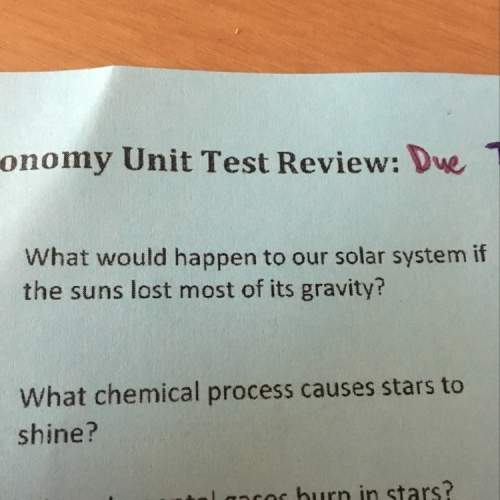Iam confused on the first question.(the one about the sun's gravity)
...

Physics, 29.12.2019 06:31, kaylonjohnwell23
Iam confused on the first question.(the one about the sun's gravity)


Answers: 3
Other questions on the subject: Physics

Physics, 21.06.2019 19:20, Obeilskzexal
Aferris wheel is a vertical, circular amusement ride with radius 9 m. riders sit on seats that swivel to remain horizontal. the ferris wheel rotates at a constant rate, going around once in 9 s. consider a rider whose mass is 56 kg. at the bottom of the ride, what is the perpendicular component of the rate of change of the rider's momentum? at the bottom of the ride, what is the vector force exerted by the seat on the rider?
Answers: 1

Physics, 21.06.2019 21:30, AleOfficial101
Aparticle with mass 1.81×10−3 kg and a charge of 1.22×10−8 c has, at a given instant, a velocity v⃗ =(3.00×104m/s)j^. what are the magnitude and direction of the particle’s acceleration produced by a uniform magnetic field b⃗ =(1.63t)i^+(0.980t)j^?
Answers: 2

Physics, 22.06.2019 06:30, bluevibe
2kg of refrigerant 134a undergoes a polytropic process in a piston-cylinder assembly from an initial state of saturated vapor at 2 bar to a final state of 12 bar, 80 degree c. a)determine the work for the process in kj. b)sketch the process on a p-v diagram.
Answers: 2

Physics, 22.06.2019 07:30, anonymous1813
Some material consisting of a collection of microscopic objects is kept at a high temperature. a photon detector capable of detecting photon energies from infrared through ultraviolet observes photons emitted with energies of 0.3 ev, 0.5 ev, 0.8 ev, 2.0ev, 2.5ev, and 2.8ev. these are the only photon energies observed. (a) draw and label a possible energy-level diagram for one of the microscopic objects, which has four bound states. on the diagram, indicate the transitions corresponding to the emitted photons. explain briefly. (b) would a spring–mass model be a good model for these microscopic objects? why or why not? (c) the material is now cooled down to a very low temperature, and the photon detector stops detecting photon emissions. next, a beam of light with a continuous range of energies from infrared through ultraviolet shines on the material, and the photon detector observes the beam of light after it passes through the material. what photon energies in this beam of light are observed to be significantly reduced in intensity (“dark absorption lines”)? explain briefly.
Answers: 3
Do you know the correct answer?
Questions in other subjects:


English, 11.11.2020 07:30



Physics, 11.11.2020 07:30

English, 11.11.2020 07:30

Mathematics, 11.11.2020 07:30

Mathematics, 11.11.2020 07:30

Mathematics, 11.11.2020 07:30






